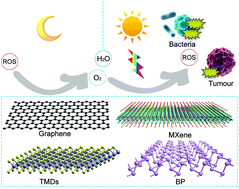Recent advances in ultrathin two-dimensional materials and biomedical applications for reactive oxygen species generation and scavenging
Abstract
Graphene and graphene-like two-dimensional (2D) nanomaterials, such as black phosphorus (BP), transition metal carbides/carbonitrides (MXene) and transition metal dichalcogenides (TMD), have been extensively studied in recent years due to their unique physical and chemical properties. With atomic-scale thickness, these 2D materials and their derivatives can react with ROS and even scavenge ROS in the dark. With excellent biocompatibility and biosafety, they show great application potential in the antioxidant field and ROS detection for diagnosis. They can also generate ROS under light and be applied in antibacterial, photodynamic therapy (PDT), and other biomedical fields. Understanding the degradation mechanism of 2D nanomaterials by ROS generated under ambient conditions is crucial to developing air stable devices and expanding their application ranges. In this review, we summarize recent advances in 2D materials with a focus on the relationship between their intrinsic structure and the ROS scavenging or generating ability. We have also highlighted important guidelines for the design and synthesis of highly efficient ROS scavenging or generating 2D materials along with their biomedical applications.

- This article is part of the themed collections: Chemistry of 2D materials: graphene and beyond and Recent Review Articles


 Please wait while we load your content...
Please wait while we load your content...